After Tet, the apricot trees begin to wither and require care to ensure that they bloom beautifully for the next Tet celebration. Let’s learn how to take care of apricot trees after Tet so that they can bloom vibrantly next year!
Methods for Caring for Apricot Flowers After Tet
You need to know how to care for apricot trees after Tet so that they can grow and bloom by the end of next year. This way, you will save money on buying new plants while still having a satisfactory apricot tree for Tet. Here are some experiences to help you.
Why is it necessary to care for apricot trees after Tet?
- During Tet, the tree focuses all its nutrients on the buds, resulting in a loss of nutrients.
- Additionally, many nurseries use excessive flowering stimulants before Tet, leading to weak root systems that cannot absorb nutrients well.
- Improper care during Tet, such as over-fertilizing, root stress, and shock from fertilization, can lead to exhaustion, weakness, and even death of the tree.
Some Notes About Apricot Trees During Tet
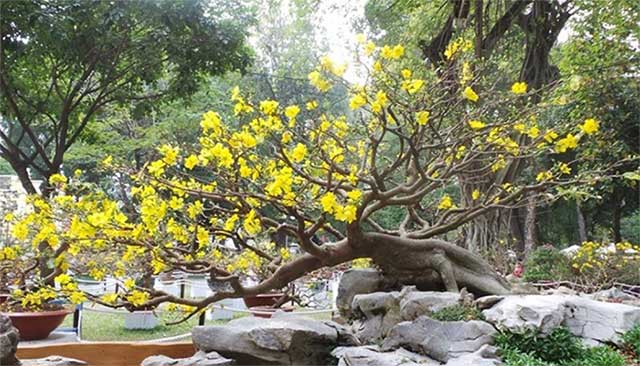
Each type of apricot requires different care.
Caring for apricot trees after Tet so that they grow well and bloom at the right season is not easy if you do not understand the rules of plant care. The method of caring for apricot trees depends on the specific type of apricot. Generally, there are three types: apricot trees in pots for indoor display, apricot trees in pots for outdoor display, and apricot trees planted in the ground. Each type of apricot tree has its own method of care after Tet and recovery.
Apricot trees typically bloom starting from the 26th day of Tet and peak from the 30th to the 1st, lasting until the 6th or 7th, which is considered the ideal blooming period that everyone desires. However, keeping apricot trees indoors for too long, where there is no sunlight, can hinder photosynthesis, causing the leaves to weaken and lose their vibrant color. Moreover, many families neglect to care for the trees, only watering them a little or even using fresh water or beer at the roots, which can affect the long-term growth and development of the apricot tree.
Most apricot trees are treated with flowering stimulants, which destabilize their physiology. During Tet, the trees must use maximum sap to nourish the flowers while living in conditions of scarcity for a week, leading to exhaustion. If you do not take good care of them, they may not bloom the following year. Therefore, caring for the apricot flowers right after purchasing is crucial, not only to ensure beautiful and timely blooming but also to significantly influence their growth and development for future use.
For Apricot Trees Displayed Indoors
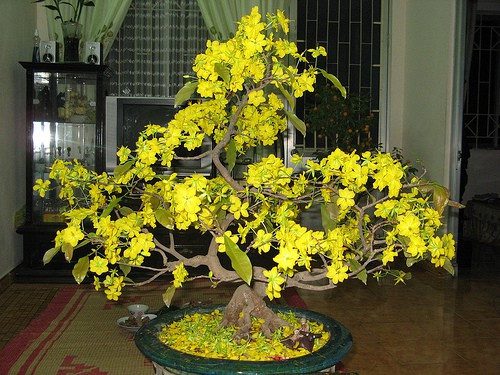
Apricot tree in indoor pot.
Apricot trees displayed indoors during Tet usually last from the 27th, 28th until the 6th of Tet. Since they are indoors, they do not receive direct sunlight, resulting in reduced photosynthesis. Consequently, their leaves become thin, pale green, and the branches stretch long but remain weak and fragile. Many homeowners do not take the time to care for the trees, only pouring a bit of water or even “watering” them with fresh water or beer at the roots.
Moreover, most apricot trees these days have been treated with flowering stimulants, resulting in unstable physiology. During this period, apricot trees must use maximum sap to support the flowers while also living in scarcity conditions for a week, which can lead to exhaustion. If not cared for properly, they may not bloom the following year.
After Tet, you should take the apricot tree outside as soon as possible, but place it in the shade to avoid direct sunlight, which can scorch the leaves. You need to remove all flowers and buds from the tree so that it does not have to expend nutrients on maintaining them.
For Apricot Trees Displayed Outdoors or Planted in the Ground
Apricot trees displayed outdoors thrive in an environment similar to their natural habitat, so you will not need to put in as much effort to care for them compared to those displayed indoors. You should also remove all flowers and buds to allow the tree to focus its nutrients on growth. Since the apricot trees are accustomed to the sunlight and wind, there is no need to move the pots into the shade.
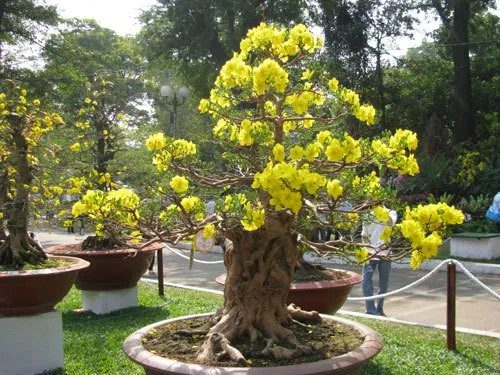
Apricot tree displayed outdoors.
How to Care for Apricot Trees After Tet
1. Prune the branches
The branches of the apricot tree should be pruned before the 15th day of the lunar month, and at the latest by the 20th. Depending on the shape and size of the apricot tree, you can prune accordingly, possibly shaping it like a Christmas tree where the upper branches are shorter than the lower ones. Generally, you will cut off about one-third of the branches.
Use about 1 teaspoon of urea mixed with 10 liters of water to spray on the tree and water around the base. If you see the tree recovering and sprouting new leaves, you do not need to apply more growth stimulants. If not, you will need to spray with the recommended dosage as indicated on the package. If you observe little growth, mix 1 gram of GA3 with 30-40 liters of water to spray on the tree and water around the base.
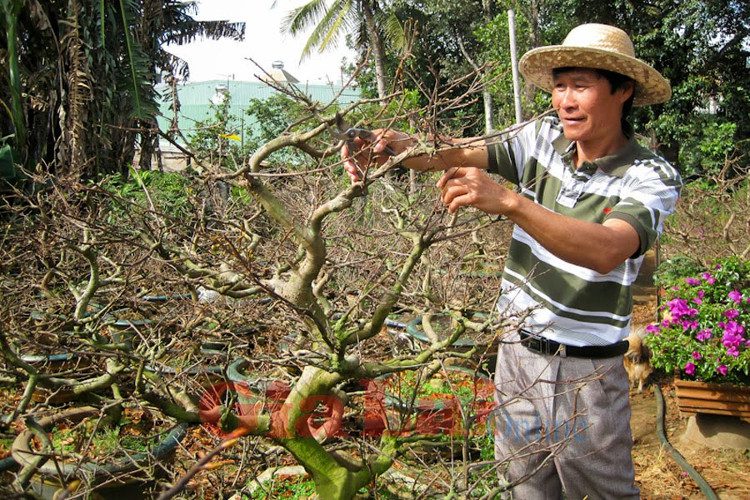
Apricot branches should be pruned before the 15th day of the lunar month, at the latest by the 20th.
When the tree has recovered, gradually expose it to sunlight. This will help the apricot tree sprout leaves and buds quickly. Note that at this stage, due to the presence of many new leaves and warm weather, pests, especially thrips, can easily infest the tree. You should mix two types of pesticides with Hexaconazole (Anvil) and Fipronil (Regent) and spray for the first time about 10 days after pruning, the second time when the tree begins to sprout, and the last time after the leaves mature.
If it is a normal year, you should prune the apricot tree’s crown around the 10th to 20th; in a leap year, you can prune later. Pruning is very important as it helps to restore light and foliage for the tree. When branches are cut, new buds will develop into new branches, carrying buds in the leaf axils—these can develop into new branches or buds (depending on photoperiod, fertilizer, temperature, and other factors).

Pruning is very important as it helps to restore light and foliage for the tree.
You need to pay attention to pruning the branches because unpruned branches are often susceptible to diseases and do not produce as many flowers as pruned branches. The closer you prune the branches to the trunk, the more vigorous they will grow.
2. Clean the Tree
After pruning the branches, the next step is to clean the tree. This is quite simple; you can use a strong water spray to wash off all the moss and mold, or you can use a strong urea solution to spray on the tree, especially in areas with heavy mold. Note: do not let the urea solution run down to the roots (you can use a plastic bag to cover the roots). After spraying for about 10 minutes, use a brush to scrub the tree vigorously to remove the mold.
3. Provide Additional Nutrients for the Tree
Use about 1 teaspoon mixed with 10 liters of water to spray on the leaves and water around the tree base. If the tree is sprouting and growing well, you do not need to fertilize further. If the tree is still slow to produce leaves, you can use additional foliar fertilizer to stimulate growth, watering around the base and spraying on the tree.
4. Some Important Notes
Absolutely do not fertilize immediately after changing the soil, as the root system cannot absorb the fertilizer; in fact, the fertilizer can even damage the roots. A small amount of base fertilizer or foliar inorganic fertilizer is sufficient for the apricot tree to grow at the beginning of the rainy season, combined with the first rains and cooler weather, lightning synthesizes natural nitrogen in the air and soil, promoting stronger growth.
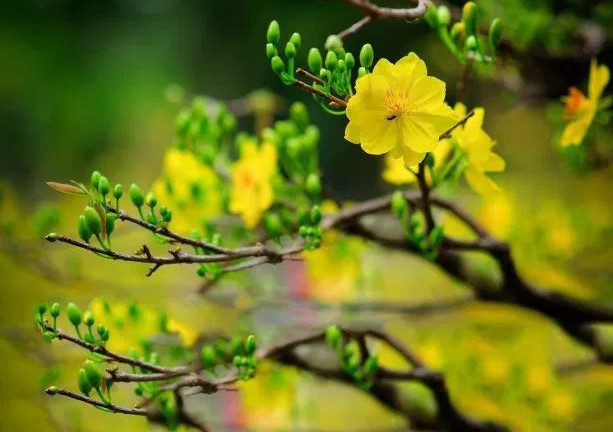
Absolutely do not fertilize immediately after changing the soil as the root system cannot absorb the fertilizer.
After Tet, we need to remove all flowers, leaves, and buds so that the nutrients can focus on nourishing the tree. If flowers and leaves are left, they will absorb all the nutrients, causing the tree to grow slowly next year.
It is advisable to keep the tree in a natural environment to allow it to absorb nutrients. Avoid disturbing the soil around the root system as this can negatively affect the tree’s growth.
The care of the apricot tree after Tet is now considered complete. The tasks mentioned help prepare the apricot tree to accumulate nutrients during the rainy season, allowing it to develop flower buds for beautiful blooms next Tet.
5. Pest and Disease Control for Apricot Trees
Common pests affecting apricot trees include leaf-eating caterpillars, stem-boring insects, red spiders, and aphids on young shoots. When the pest attack is minimal, a manual method of hand-picking can be employed. For aphids, when their population is still low, a strong water spray can be used on the undersides of the leaves. When the population is high, a preventive spray using a solution of garlic, chili, and ginger can be applied to the trees.
Notably, pests and harmful insects tend to attack apricot trees during the flowering bud stage, particularly ants, aphids, and generalist caterpillars. At this time, it is crucial to spray the apricot flowers with a solution of cinnamon or lemongrass.
6. Tips for Cultivating Beautiful Apricot Tree Shapes
When replacing the soil for the tree, choose nutrient-rich alluvial soil that is free from acidity, salinity, and alkalinity. You can mix sand with clay soil or use coconut coir and rice husks to enhance moisture and nutrient retention.
A small amount of base fertilizer or a light spray of inorganic foliar fertilizer is sufficient for the apricot tree to thrive at the beginning of the rainy season. Coupled with early seasonal rains, cooler weather, and thunder can help synthesize natural nitrogen from the air and soil, promoting stronger growth and altering the tree’s shape.
Do not overlook the process of replacing the soil when caring for the apricot tree; use new soil to rejuvenate the plant. This action is aimed at replenishing the necessary potassium and nitrogen levels for the crops.
You should cover the surface with a layer of sand and organic fertilizer, then add a bit of planting soil before firmly placing the tree in.
Thus, the care of the yellow apricot tree after Tet is complete. Be sure to prepare well for your family’s apricot tree to welcome a vibrant yellow apricot season filled with luck and prosperity next year.
7. Monthly Care Process for Apricot Trees
Care for Apricot Trees from January to June
- From January to June is the post-Tet phase, when the tree has weakened, making it an ideal time for recovery.
- Prune 30% of the branches.
- Replace the soil for the tree and mix in some nutrients to nourish it.
- Add more phosphorus fertilizer.
- Water correctly.
- Expose the tree to sunlight; every two weeks, rotate the apricot tree 180 degrees for even growth.
Care for Apricot Trees from June to December
From June to December, the tree becomes healthy and vibrant. However, it still requires a high nutrient regimen, so focus on applying fertilizers high in nitrogen and phosphorus.
Be cautious of seasonal pests such as leaf spots and rust. By the end of November, start pruning all the leaves so that the tree can concentrate nutrients on the buds.


















































